

Home
About Us
Allotments
Garden Equipment
Seed Suppliers
Manure Problems
Solve It - Puzzles
Children's Pages
GLA Blog
Weather Blog
School Veg Patch
Useful Links
Weather Blog
Garden Video Blog
Propagators
** This website is not a shop and doesn’t sell anything! **
Be aware that any external links may contain cookies and you should refer to the particular website's cookie policy
In order to grow successfully some seeds need a higher temperature that others. This may be achieved by keeping the seeds in a warm place inside the house, however once the seeds have germinated the problem then is how to provide them with sufficient light to prevent the seedlings from becoming weak and leggy.
Although gardeners will often be advised to grow seeds on house windowsills there is rarely adequate levels of light. Light will come from one side only forcing the seedling to stretch towards the source which produces weak growth. Seedlings growing on windowsills in direct sunlight may also be burned. Possibly the only suitable windowsill would be in a light and airy but heated conservatory.
Heating a greenhouse is often too costly and so an alternative means of germinating some seeds may be required and at this point you may consider a propagator.
Some seedlings and cuttings also need to be kept in a humid environment. At it’s most basic this can be achieved by placing inside a plastic bag but keeping the bag from touching the plant leaves can be a problem. It is important that your propagator allows for adequate ventilation or plants can become subject to fungal disease. Ventilation is often achieved in propagators by use of adjustable vents.
Not only are propagators useful for bringing on seedlings or cuttings but they can also be used to enable you to protect your most treasured plants over the winter period. If this appeals to you, you need to consider a propagator with more headroom!
With so many different types of propagators on the market you should first consider what you will use a propagator for.
- What conditions do the seeds and plants that you wish to grow need?
- Do you need a propagator just for raising seeds or does it need to be large enough to house cutting?
- Where will the propagator be used if it needs a power supply?
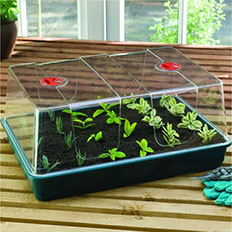 Unheated propagators
Unheated propagators
The simplest type of propagators are really just a seed tray with a domed plastic cover. You can also buy just the lids to use with existing seed trays. These do tend to be flimsy and not very long lasting and also have no ventilation slots so the only means of ventilation is to prop open the lid.
There are also seed tray size propagators with rigid dome shaped lids which can house taller plants, they also have ventilation openings. You can also find the lids for purchase separately.
Unheated propagators come in various sizes including a set that can be placed on a windowsill but again light may be a problem meaning seedlings need to be moved on soon after germination.
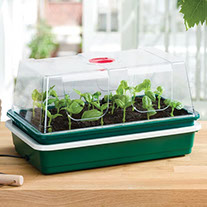

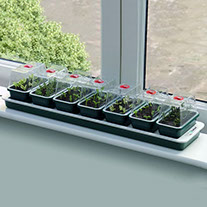
Heated Propagators
A heated propagator need access to an electricity power supply. Usually warming cables in the base of the propagator provide the heat. Bottom heat is required by some cuttings in order to root more successfully.
Good heated propagators also have thermostatic controls which allow you to regulate the plants' temperature requirements more precisely.
There is a very wide choice of styles available and a very wide price range too. They are available in a range of sizes too some being almost as large as a mini-greenhouse.
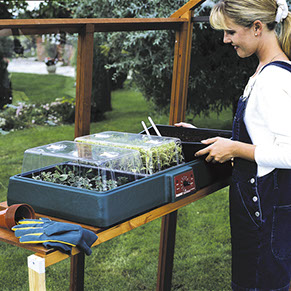
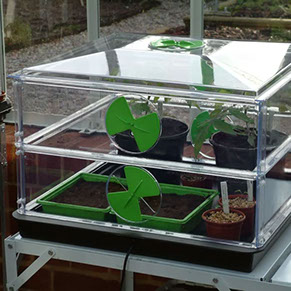
Warming mats and cables
You can also buy soil warming mats and cables which will deliver bottom heat to plants. These can be used with or without a lid or covering.
You could also construct a wooden propagator and use a soil warming cable or mat to heat it.


Lighting
When raising seedlings indoors they can become drawn and leggy due to lack of sufficient daylight. This can even be a problem when seed trays are sitting on a windowsill as light only comes from one direction.
A couple of years ago we bought a seed raising system that includes a light source. We found this extremely useful in enabling us to sow seeds early without the worry of transferring them to our cold greenhouse before the temperature inside had risen sufficiently. The system also incorporated a water reservoir and so we managed to even sow seeds just before we were due to go on holiday for a week. The system kept the seeds and seedlings watered for our week’s absence.
During the winter months we used the system to grow fresh salad leaves. More about how we used this system can be read here
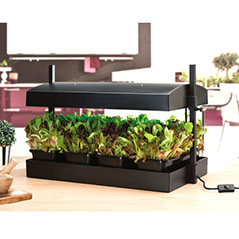
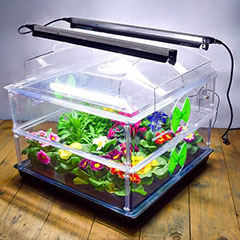
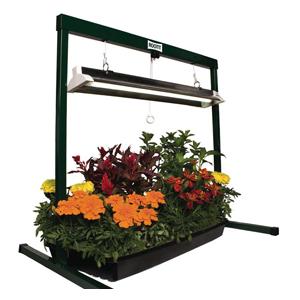
Photographs taken from Harrod Horticultural and Greenfingers
I’ve gathered together some links from companies offering gardening products for sale. I have no connection to the suppliers and therefore cannot be held responsible for any changes in items available or any issues that may arise when making a purchase.
Some companies give me a small commission on sales that are generated from this website which helps me to maintain this and sister websites but this in no way means that I am recommending purchases from a particular company.
Our Plot at Green Lane Allotments Blog | A Gardener's Weather Diary | School Vegetable Patch Website
© Our Plot on Green Lane Allotments - Please email me if you wish to use any of this site's content